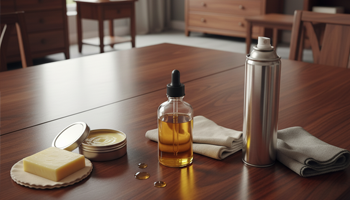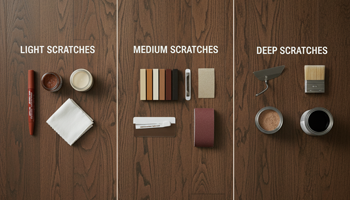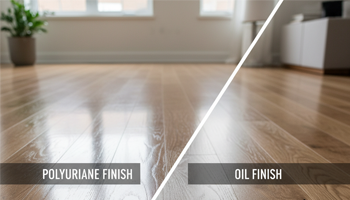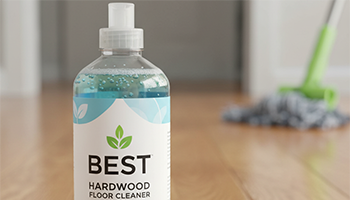Wax vs Oil vs Spray — Comparison for Furniture
Quick plan (what you’ll get):
- Clear, hands-on comparison of wax, oil, and spray polishes with real-world use cases and long-tail answers (e.g., “best wood polish for polyurethane finish furniture”).
- Field-tested picks with a multi-criteria comparison table (shine, application, dust resistance, longevity, price per use).
- Step-by-step techniques, finish-ID (acetone test), silicone controversy explained, DIY options, and FAQs.
Understanding Wood Polish Types and Purposes
What Polish Actually Does (vs Cleaner)
Polish enhances sheen, feel, and minor protection. Cleaners remove grime. If you trap dust and body oils under a polish, you seal in the problem. Always clean first (a few drops of mild dish soap in warm water, wrung-out microfiber; then dry), then polish. In my shop, half the “polish fails” I’m called to fix were simply polish over dirt, not bad products.
Identifying Your Furniture Finish First
Matching product to finish is everything. Use this quick acetone spot test in a hidden area:
- Shellac: a single drop softens quickly or gets sticky.
- Lacquer: softens more slowly; may get tacky.
- Polyurethane/varnish: no effect; rock solid.
- Oil finish (Danish/Tung): wood feels close to bare; little to no film.
If you’re unsure, assume a modern polyurethane on big-box furniture and a shellac or lacquer on antiques and mid-century pieces.
Why Mixing Polish Types Damages Furniture
Stacking silicone spray over wax, or oily polishes under hard wax creates adhesion problems and blotchy sheen. Worst case, siliconized residues complicate future refinishing.
Paste Wax Polishes: Traditional Gold Standard
Beeswax vs Carnauba Wax Differences
- Beeswax: warm glow, softer, easy to buff; modest hardness.
- Carnauba: higher-gloss, harder, more abrasion resistance; buffing needs more elbow grease.
Many premium pastes blend both: beeswax for glow, carnauba for durable shine.
Johnson’s Paste Wax Review (Budget Champion)
Reliable, available, and surprisingly long-lasting. It lays thin, buffs to a classic satin. For value per square foot, it’s hard to beat—ideal for learning proper paste-wax technique.
Renaissance Wax Review (Museum Quality)
Microcrystalline wax used by conservators; exceptionally stable, non-yellowing, and removable. On rare pieces, I default to this because it protects without altering the look. It’s the pro secret for heirlooms and antiques (developed within the British Museum Research Laboratory).
Application Technique and Buffing
- Work paper-thin. If you see white haze, you’ve used too much.
- Apply with a soft pad in small circles, then with-the-grain.
- Dry/haze for 5–15 minutes; buff vigorously with clean microfiber.
- Pro tip: After buffing, a clean fingertip should glide smooth, not oily. If it feels greasy, you over-applied.
When to Use: Best for Antiques and Low-Use Pieces
Paste wax excels on shellac and lacquer, antique finishes, and low-traffic tops (china cabinets, sideboards). It creates a sacrificial layer and authentic sheen.
Lifespan: 6–12 Months Per Application
On seldom-touched surfaces, expect up to a year. Dining tables with daily use: plan for every 3–6 months.
Oil-Based Polishes: Nourishing and Restoring
Howard Feed-N-Wax Review (Oil + Wax Hybrid)
Beeswax + carnauba + orange oil: revives dry, natural wood and oil finishes. Leaves a warm, “fed” look. I use it on oiled walnut cases where paste wax looks too sealed.
Guardsman Anytime Clean & Polish Analysis
A balanced, silicone-free formula that cleans light smudges and boosts luster in one pass. For most modern furniture, it’s the best daily driver without buildup.
Old English vs Modern Alternatives
Old English can color-blend scratches on dark furniture, but modern non-silicone blends (e.g., Guardsman, Method) typically attract less dust and are safer across finishes.
Application Method and Drying Time
- Apply a small amount on a microfiber; wipe with the grain.
- Let it sit 5–10 minutes (for hybrids), then buff dry.
- Monthly to quarterly is usually right; more frequent light upkeep beats heavy, infrequent applications.
Best for: Natural Wood and Oil Finishes
Oil polishes suit penetrating oil finishes (Tung/Danish) and thirsty wood that looks chalky or dry.
Frequency: Monthly to Quarterly
Oil components flash off faster than wax films; light, regular upkeep avoids gummy build.
Spray Polishes: Convenient Modern Option
Silicone-Based Sprays (Pledge, Endust)
High instant shine and slick feel. Great on modern polyurethane when used correctly; not so great on antique or refinish-likely pieces due to silicone residue.
Silicone-Free Alternatives (Method, Guardsman)
Method Wood Polish (Almond) and Guardsman sprays are silicone-free workhorses. They clean + brighten without the slippery film. My go-to for daily-use modern furniture is Method—smells clean, wipes streak-free.
The Dust-Attraction Debate
Dust sticks to oily films more than to thin, dry wax layers. Silicone can reduce friction (less dust clings), but oily residues and over-application are the usual culprits behind “this product attracts dust” complaints.
Best for: Daily Use Furniture and Quick Touch-ups
Sprays shine on kitchen tables, media consoles, and anything that sees fingerprints daily.
Warning: Not for Antiques
Skip sprays on shellac/lacquer antiques or museum-grade pieces—they complicate future conservation.
Product Testing and Rankings
Top Picks
- Best Overall: Guardsman Anytime Clean & Polish
- Best Value: Johnson’s Paste Wax
- Best Natural: Howard Feed-N-Wax
- Best Spray: Method Wood Polish (Almond Scent)
- Best for Antiques: Renaissance Wax
Multi-Criteria Comparison
| Product | Shine Level (★1–5) | Ease of Application | Dust Resistance | Longevity | Price per Use* |
|---|---|---|---|---|---|
| Guardsman Anytime Clean & Polish | ★★★★☆ | Very easy (spray/wipe) | High | Weeks | Low |
| Johnson’s Paste Wax | ★★★★☆ | Moderate (buffing) | Very high | 6–12 months | Very low |
| Howard Feed-N-Wax | ★★★☆☆ | Easy (wipe/buff) | Medium | 1–3 months | Low |
| Method Wood Polish (Almond) | ★★★☆☆ | Very easy | Medium-High | Weeks | Low |
| Renaissance Wax | ★★★★☆ | Moderate (thin coats) | Excellent | 6–12+ months | Medium |
*Approximate, assuming thin, correct application. Paste waxes spread over many uses.
Testing notes (from the bench): After each application, I do a finger glide test—a good finish feels silky, not greasy. I also check dust pickup after 48 hours in a normal living space. Johnson’s and Renaissance, when buffed thin, consistently collect less visible dust than oilier products.
Silicone: The Controversy Explained
Benefits of Silicone (Shine, Protection)
Silicone boosts immediate gloss and slickness; fingerprints wipe off easily. That’s why some consumer tests love it.
Drawbacks (Buildup, Refinishing Issues)
Silicone can migrate into pores and is notoriously difficult to remove, causing fish-eye defects during refinishing. I once handled a 1910 Stickley desk (~$30,000) that had been sprayed with Pledge for years; we had to strip to bare wood, losing original patina (and value).
When to Avoid Silicone Completely
- Antiques and anything with shellac or lacquer.
- Pieces you or a future owner may refinish.
- High-value heirlooms; stick to microcrystalline or paste wax.
For balanced viewpoints on waxes and finishing behaviors, trade sources like Fine Woodworking are useful, while consumer buying guides such as Bob Vila can clarify mainstream picks
Application Techniques by Polish Type
Paste Wax: Thin Coats and Elbow Grease
- Less is more. Work a whisper-thin coat; wait; buff hard.
- Two thin coats beat one thick coat.
- Ventilate; swap cloths as they load.
Oil Polish: Following the Grain
- Dampen, don’t drench, the cloth.
- Work with the grain; wait 5–10 min; buff until dry to the touch.
- Avoid edges/joints where oil can creep.
Spray: Proper Distance and Buffing
- Spray the cloth, not the surface, to avoid overspray.
- 8–10 inches if spraying directly; immediate buff.
- For glass-adjacent areas, shield to prevent mist.
Common Application Mistakes
- Over-application (greasy feel, dust magnet).
- Skipping cleaning first.
- Mixing incompatible products (silicone over wax).
Matching Polish to Furniture Finish
Polyurethane and Varnish: Spray or Light Oil
For polyurethane finish furniture (most modern pieces), use silicone-free sprays (Method, Guardsman) or light oil polishes for quick sheen without buildup. This is the best wood polish for polyurethane finish furniture in everyday homes.
Shellac and Lacquer: Paste Wax Only
Use paste wax (Johnson’s) or microcrystalline (Renaissance). Avoid silicone and heavy oils.
Oil Finish: Oil-Based Polish or Wax
Feed-N-Wax or a true drying oil maintenance schedule; finish with a thin wax if you want fingerprint resistance.
Painted Furniture: Special Considerations
Gentle, silicone-free sprays or a microcrystalline wax. Test first; some chalk paints mark easily.
Natural DIY Polish Recipes
Beeswax and Olive Oil Formula
Melt 1 part beeswax into 3 parts light oil; cool; apply thin. Pros: pleasant glow. Cons: can be softer and collect dust if over-applied.
Vinegar and Oil Cleaner/Polish
1:1 white vinegar + mineral oil; shake. Good for clean-and-sheen on modern finishes. Avoid on shellac.
Lemon Oil Homemade Version
A few drops of pure lemon essential oil in mineral oil. Smells great; non-drying, so buff to dry.
Cost Comparison: DIY vs Commercial
DIY wins per ounce, but commercial blends control viscosity and curing for better dust resistance and streak control.
Products to Avoid and Why
Pledge on Antiques (Never!)
Not “poison,” but the silicone complicates restoration. Fine on modern polyurethane if you’ll never refinish—but I still prefer silicone-free options for easier maintenance.
Lemon Oil Spray Issues
Many “lemon” products are scented mineral oil. They can leave a film and attract dust if not buffed thoroughly.
Multi-Surface Products on Fine Wood
Glass + wood combos often contain surfactants that streak or dull fine finishes. Stick to purpose-made wood care.
FAQs
How often should you polish wood furniture?
- Sprays: weekly to bi-weekly light wipes.
- Oils: monthly to quarterly.
- Paste wax: every 6–12 months on low-touch pieces.
Can you use Pledge on antique wood furniture?
No—avoid silicone on shellac/lacquer antiques. Use paste wax instead.
What’s the difference between furniture wax and furniture polish?
Wax leaves a dry, protective film; polish (often oil-based) leaves a conditioning residue and quick luster.
Is there a wood polish that adds shine but no buildup?
Yes: thin paste-wax coats (buffed hard) or silicone-free sprays used sparingly.
Best wood polish for polyurethane finish furniture?
Method Wood Polish (Almond) or Guardsman Anytime—silicone-free, easy, safe for routine care.
Editor’s Picks
- Daily-use modern furniture: Method Wood Cleaner/Polish (silicone-free, breezy maintenance).
- Heirloom/antiques: Johnson’s Paste Wax; upgrade to Renaissance Wax for museum-grade care.
- Natural oil-finished wood: Howard Feed-N-Wax (revives dryness).
- Quick touch-ups: Guardsman Anytime Clean & Polish.
If you identify the finish first, the rest is easy: wax for antiques and classic films, oil-hybrids to feed tired wood, and sprays (preferably silicone-free) for quick, modern maintenance. Keep coats ultra-thin, always clean first, and remember: a surface should feel silky, never greasy.
Selecting the right polish fits the maintenance timeline from Interior Wood Care, with surface prep covered in Remove Water Stains from Wood Furniture.
Currently viewing
Best Wood Polish

Repair Scratches in Hardwood Floors
How to Repair Scratches in Hardwood Floors: Complete Guide by Severity Level If you’re staring…
Refinishing Hardwood Floors
Sand & Refinish vs Screen & Recoat — Complete Comparison Guide If you’re weighing screen…
Polyurethane vs Oil Finish Floors
Durability & Maintenance Comparison If you’re comparing polyurethane vs oil finish for hardwood floors, you’re…
Best Hardwood Floor Cleaner
pH-Neutral & No-Residue Options TL;DR (buyer’s snapshot): For most homes, a pH-neutral hardwood floor cleaner…
Hardwood Floor Care Masterclass
Complete Guide by Wood Species & Finish If you want hardwood floor care by species…





